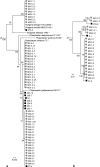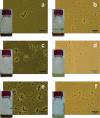Phaeobacter and Ruegeria species of the Roseobacter clade colonize separate niches in a Danish Turbot (Scophthalmus maximus)-rearing farm and antagonize Vibrio anguillarum under different growth conditions
- PMID: 18952864
- PMCID: PMC2592939
- DOI: 10.1128/AEM.01738-08
Phaeobacter and Ruegeria species of the Roseobacter clade colonize separate niches in a Danish Turbot (Scophthalmus maximus)-rearing farm and antagonize Vibrio anguillarum under different growth conditions
Abstract
Members of the Roseobacter clade colonize a Spanish turbot larval unit, and one isolate (Phaeobacter strain 27-4) is capable of disease suppression in in vivo challenge trials. Here, we demonstrate that roseobacters with antagonistic activity against Vibrio anguillarum also colonize a Danish turbot larval farm that relies on a very different water source (the Danish fiord Limfjorden as opposed to the Galician Atlantic Ocean). Phylogenetic analyses based on 16S rRNA and gyrase B gene sequences revealed that different species colonized different niches in the larval unit. Phaeobacter inhibens- and Phaeobacter gallaeciensis-like strains were primarily found in the production sites, whereas strains identified as Ruegeria mobilis or Ruegeria pelagia were found only in the algal cultures. Phaeobacter spp. were more inhibitory against the general microbiota from the Danish turbot larval unit than were the Ruegeria spp. Phaeobacter spp. produced tropodithietic acid (TDA) and brown pigment and antagonized V. anguillarum when grown under shaking (200 rpm) and stagnant (0 rpm) conditions, whereas Ruegeria spp. behaved similarly to Phaeobacter strain 27-4 and expressed these three phenotypes only during stagnant growth. Both genera attached to an inert surface and grew in multicellular rosettes after stagnant growth, whereas shaking conditions led to single cells with low attachment capacity. Bacteria from the Roseobacter clade appear to be universal colonizers of marine larval rearing units, and since the Danish Phaeobacter spp. displayed antibacterial activity under a broader range of growth conditions than did Phaeobacter strain 27-4, these organisms may hold greater promise as fish probiotic organisms.
Figures



References
-
- Alavi, M., T. Miller, K. Erlandson, R. Schneider, and R. Belas. 2001. Bacterial community associated with Pfiesteria-like dinoflagellate cultures. Environ. Microbiol. 3:380-396. - PubMed
-
- Arahal, D. R., A. M. Castillo, W. Ludwig, K. H. Schleifer, and A. Ventosa. 2002. Proposal of Cobetia marina gen. nov., comb. nov., within the family Halomonadaceae, to include the species Halomonas marina. Syst. Appl. Microbiol. 25:207-211. - PubMed
-
- Bhattarai, H. D., Y. K. Lee, K. H. Cho, H. K. Lee, and H. W. Shin. 2006. The study of antagonistic interactions among pelagic bacteria: a promising way to coin environmental friendly antifouling compounds. Hydrobiologia 568:417-423.
Publication types
MeSH terms
Substances
Associated data
- Actions
- Actions
- Actions
- Actions
- Actions
- Actions
- Actions
- Actions
- Actions
- Actions
- Actions
- Actions
- Actions
- Actions
- Actions
- Actions
- Actions
- Actions
- Actions
- Actions
- Actions
- Actions
LinkOut - more resources
Full Text Sources
Other Literature Sources
Molecular Biology Databases
Miscellaneous

